标签:clu lines 网上 method ticket ann 案例 css make
MapServer Tutorial——MapServer7.2.1教程学习——第一节用例实践:Example 1.4 Labeling the Map
一、前言
MapServer拥有非常灵活的标签标记系统。它支持bitmap以及truetype字体等。使用truetype字体同时还支持其缩放。标签的角度和位置是可以自定义的。
通过把标签的位置和角度以及其他参数的设置使用,你可以把你的地图装饰得更加美观,信息体现的更加丰富。
二、搭建Example1.4站点
所有的学习都要通过实践,还是从搭建站点开始。
在cmd中输入:cd /d E:\SvnWorkspace\LY_WEB_GIS\branches\Documents\ms4w-mapserver-for-wimdows\release-1911-x64-gdal-2-3-3-mapserver-7-2-1\apps
在cmd中输入:md Example1.4
在cmd中输入:cd Example1.4
在cmd中输入:md data
在cmd中输入:md logs
在cmd中输入:md fonts
在cmd中输入:cd.>web.config
在cmd中输入:cd.>example1_4.map
将states_ugl.dbf、states_ugl.shp、states_ugl.shx等三个文件放入到data文件夹下面。
将tutorial/fonts中的fonts.list、Vera.ttf(所有的.ttf字体文件)拷贝到Example1.4/fonts文件夹中。
(如果不清楚tutorial文件夹是怎么回事,请查看《MapServer Tutorial——MapServer7.2.1教程学习——教程背景》,里面有样例说明和应用数据下载地址:http://download.osgeo.org/mapserver/docs/mapserver-tutorial.zip)
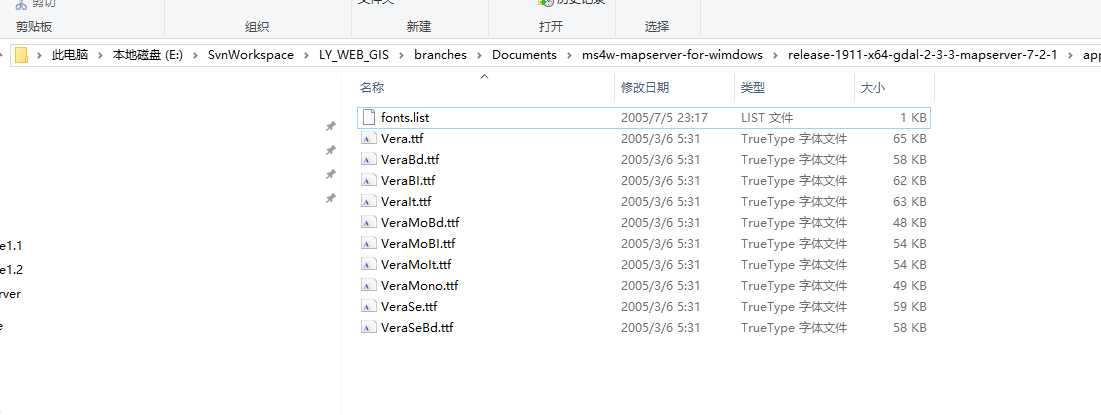
在IIS中创建Example1.4站点,端口8014。web.config内容如下:
<?xml version="1.0" encoding="UTF-8"?> <configuration> <system.webServer> <handlers> <add name="MapServerFastCgi" path="*" verb="*" type="" modules="FastCgiModule"
scriptProcessor="E:\SvnWorkspace\LY_WEB_GIS\branches\Documents\ms4w-mapserver-for-wimdows\release-1911-x64-gdal-2-3-3-mapserver-7-2-1\bin\mapserv.exe"
resourceType="Unspecified" requireAccess="Script" allowPathInfo="false" preCondition="" /> </handlers> <caching enabled="true" enableKernelCache="true" /> </system.webServer> </configuration>
给应用程序池添加对logs文件夹的读写权限。
在cmd中输入:icacls "E:\SvnWorkspace\LY_WEB_GIS\branches\Documents\ms4w-mapserver-for-wimdows\release-1911-x64-gdal-2-3-3-mapserver-7-2-1\apps\Example1.4\logs" /grant "IIS AppPool\Example1.4":(OI)(CI)RW
mapfile(example1_4.map)文件如下:
# The annotated map file (sort of)
# Created by Pericles S. Nacionales for the MapServer tutorial
# 20050408
#
# MapServer map file uses the pound sign (#) to denote the start of a line
# comment--each line that needs to be commented has to be prepended with a "#".
#
# Map files begin with MAP keyword to signify the start of the map object.
# Well, the entire map file is THE map object. Enclosed between MAP and END
# at the very bottom of this map file, are keyword/value pairs and other
# objects.
MAP
IMAGETYPE PNG
EXTENT -97.238976 41.619778 -82.122902 49.385620
SIZE 400 300
SHAPEPATH "./data"
IMAGECOLOR 255 255 255
FONTSET "./fonts/fonts.list"
# Layer objects are defined beneath the map object. You need at least one
# layer defined in your map file before you can display a map... You can
# define as many layers as you‘d like although a limit is typically hard-coded
# in map.h in the MapServer source. The default limit is set at 100. You‘d
# have to have a very specialized application to need more than 100 layers in
# your application.
# Start of LAYER DEFINITIONS ---------------------------------------------
LAYER # States polygon layer begins here
NAME states_poly
DATA states_ugl
STATUS OFF
TYPE POLYGON
# CLASSITEM defines the non-spatial attribute that you will be using to
# separate a layer into classes. This attribute will be in the DBF file
# of your shapefile (it will be different for each data format). In this
# example the shapefile states_ugl has an associated database
# (states_ugl.dbf) that contains an attribute called "CLASS". You will be
# using two values in the CLASS attribute to separate the classes (also
# called themes) used in this layer--land and water. CLASSITEM is used in
# association with the EXPRESSION parameter in the CLASS object. See below.
CLASSITEM "CLASS"
# Just like CLASSITEM, LABELITEM defines the database attribute that you
# will be using to draw labels. In this case, the values of the attribute
# "STATE" will be used to label the states polygons.
LABELITEM "STATE"
# The class object is defined within the layer object. You can define as
# many classes as you need (well, there are limits as with layers, but it‘s
# senseless to define more than ten on a "normal" layer. There are
# situations, however, where you might have to do it.)
CLASS
NAME ‘States‘
EXPRESSION ‘land‘
# There are styles in a class, just like there are classes in a layer,
# just like there are layers in a map. You can define multiple styles in
# a class just as you can define multiple classes in a layer and multiple
# layers in a map.
STYLE
COLOR 232 232 232
END
# There can be labels in a class, just like there are classes in a layer,
# just like there are layers in a map. You can define multiple labels in
# a class just as you can define multiple classes in a layer and multiple
# layers in a map.
# MapServer has a very flexible labeling system. With that flexibility
# comes complexity, specially when using truetype fonts. Please read
# through the LABEL section of the MapServer map file documentation at
# http://www.mapserver.org/mapfile for more information.
LABEL
COLOR 132 31 31
TYPE TRUETYPE
FONT arial-bold
SIZE 12
ANTIALIAS TRUE
POSITION CL
PARTIALS FALSE
MINDISTANCE 300
BUFFER 4
# create a background shadow
# Note that the tutorial package has not been updated, so this has
# to be done manually!
#SHADOWCOLOR 218 218 218 # prior to version 6
#SHADOWSIZE 2 2 # prior to version 6
STYLE # since to version 6
GEOMTRANSFORM ‘labelpoly‘
COLOR 218 218 218
OFFSET 2 2
END # STYLE
END # end of label
END
CLASS
NAME ‘Water‘
EXPRESSION ‘water‘
STYLE
COLOR 198 198 255
END
END
END # States polygon layer ends here
LAYER # States line layer begins here
NAME states_line
DATA states_ugl
STATUS OFF
TYPE LINE
CLASSITEM "CLASS"
CLASS
NAME ‘State Boundary‘
EXPRESSION ‘land‘
STYLE
COLOR 64 64 64
END
END
END # States line layer ends here
# End of LAYER DEFINITIONS -------------------------------
END # All map files must come to an end just as all other things must come to...
在浏览器中输入:http://localhost:8014/mapserv?map=../apps/Example1.4/example1_4.map&layer=states_poly&layer=states_line&mode=map
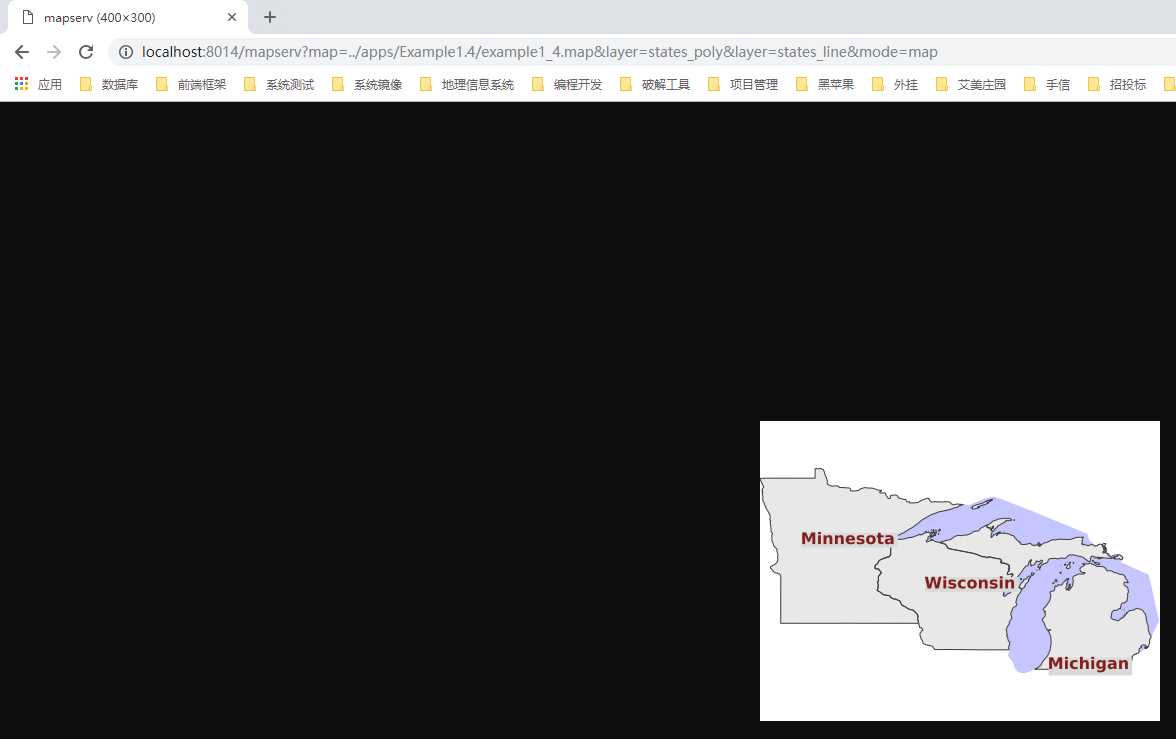
三、MapFIle文件(example1_4.map)讲解
MapFIle文件结构
MAP (states_poly) LAYER----------|---------LAYER (states_line) (land) CLASS-----|-CLASS (water) |-CLASS STYLE-|-LABEL |-STYLE |-STYLE</pre>
LABEL 对象以及其中的关键词
FONTSET
指定字体文件清单文件的全路径或相对路径(如:./fonts/fonts.list 或 E:\SvnWorkspace\LY_WEB_GIS\branches\Documents\ms4w-mapserver-for-wimdows\release-1911-x64-gdal-2-3-3-mapserver-7-2-1\apps\Example1.4\fonts\fonts.list)
fonts.list 文件由两部分组成,名称和路径(相对路径或绝对路径)。
名称是路径所对应的字体集的实际名称(如:Vera.ttf 是当前文件,但是其字体的实际名称是arial)。
路径是Vera.ttf文件与fonts.list的相对路径或绝对路径。
当前案例中,fonts.list 文件与 ttf字体文件均在 fonts 文件夹下面。可查看 fonts.list 内容,此案例中采用的是相对路径。
# This be the fonts list arial Vera.ttf arial-bold VeraBd.ttf arial-italic VeraIt.ttf arial-bold-italic VeraBI.ttf times VeraSe.ttf times-bold VeraSeBd.ttf andale-mono VeraMono.ttf vera_sans Vera.ttf vera_sans-bold VeraBd.ttf vera_sans-italic VeraIt.ttf vera_sans-bold-italic VeraBI.ttf vera_sans_mono VeraMono.ttf vera_sans_mono-bold VeraMoBd.ttf vera_sans_mono-italic VeraMoIt.ttf vera_sans_mono-bold-italic VeraMoBI.ttf vera_serif VeraSe.ttf vera_serif-bold VeraSeBd.ttf
如果我们采用绝对路径试试(顺便把mapfile文件中的LABEL对象里面的FONT修改为arial-italic):
# This be the fonts list arial E:\SvnWorkspace\LY_WEB_GIS\branches\Documents\ms4w-mapserver-for-wimdows\release-1911-x64-gdal-2-3-3-mapserver-7-2-1\apps\Example1.4\fonts\Vera.ttf arial-bold E:\SvnWorkspace\LY_WEB_GIS\branches\Documents\ms4w-mapserver-for-wimdows\release-1911-x64-gdal-2-3-3-mapserver-7-2-1\apps\Example1.4\fonts\VeraBd.ttf arial-italic E:\SvnWorkspace\LY_WEB_GIS\branches\Documents\ms4w-mapserver-for-wimdows\release-1911-x64-gdal-2-3-3-mapserver-7-2-1\apps\Example1.4\fonts\VeraIt.ttf arial-bold-italic E:\SvnWorkspace\LY_WEB_GIS\branches\Documents\ms4w-mapserver-for-wimdows\release-1911-x64-gdal-2-3-3-mapserver-7-2-1\apps\Example1.4\fonts\VeraBI.ttf times E:\SvnWorkspace\LY_WEB_GIS\branches\Documents\ms4w-mapserver-for-wimdows\release-1911-x64-gdal-2-3-3-mapserver-7-2-1\apps\Example1.4\fonts\VeraSe.ttf times-bold E:\SvnWorkspace\LY_WEB_GIS\branches\Documents\ms4w-mapserver-for-wimdows\release-1911-x64-gdal-2-3-3-mapserver-7-2-1\apps\Example1.4\fonts\VeraSeBd.ttf andale-mono E:\SvnWorkspace\LY_WEB_GIS\branches\Documents\ms4w-mapserver-for-wimdows\release-1911-x64-gdal-2-3-3-mapserver-7-2-1\apps\Example1.4\fonts\VeraMono.ttf vera_sans E:\SvnWorkspace\LY_WEB_GIS\branches\Documents\ms4w-mapserver-for-wimdows\release-1911-x64-gdal-2-3-3-mapserver-7-2-1\apps\Example1.4\fonts\Vera.ttf vera_sans-bold E:\SvnWorkspace\LY_WEB_GIS\branches\Documents\ms4w-mapserver-for-wimdows\release-1911-x64-gdal-2-3-3-mapserver-7-2-1\apps\Example1.4\fonts\VeraBd.ttf vera_sans-italic E:\SvnWorkspace\LY_WEB_GIS\branches\Documents\ms4w-mapserver-for-wimdows\release-1911-x64-gdal-2-3-3-mapserver-7-2-1\apps\Example1.4\fonts\VeraIt.ttf vera_sans-bold-italic E:\SvnWorkspace\LY_WEB_GIS\branches\Documents\ms4w-mapserver-for-wimdows\release-1911-x64-gdal-2-3-3-mapserver-7-2-1\apps\Example1.4\fonts\VeraBI.ttf vera_sans_mono E:\SvnWorkspace\LY_WEB_GIS\branches\Documents\ms4w-mapserver-for-wimdows\release-1911-x64-gdal-2-3-3-mapserver-7-2-1\apps\Example1.4\fonts\VeraMono.ttf vera_sans_mono-bold E:\SvnWorkspace\LY_WEB_GIS\branches\Documents\ms4w-mapserver-for-wimdows\release-1911-x64-gdal-2-3-3-mapserver-7-2-1\apps\Example1.4\fonts\VeraMoBd.ttf vera_sans_mono-italic E:\SvnWorkspace\LY_WEB_GIS\branches\Documents\ms4w-mapserver-for-wimdows\release-1911-x64-gdal-2-3-3-mapserver-7-2-1\apps\Example1.4\fonts\VeraMoIt.ttf vera_sans_mono-bold-italic E:\SvnWorkspace\LY_WEB_GIS\branches\Documents\ms4w-mapserver-for-wimdows\release-1911-x64-gdal-2-3-3-mapserver-7-2-1\apps\Example1.4\fonts\VeraMoBI.ttf vera_serif E:\SvnWorkspace\LY_WEB_GIS\branches\Documents\ms4w-mapserver-for-wimdows\release-1911-x64-gdal-2-3-3-mapserver-7-2-1\apps\Example1.4\fonts\VeraSe.ttf vera_serif-bold E:\SvnWorkspace\LY_WEB_GIS\branches\Documents\ms4w-mapserver-for-wimdows\release-1911-x64-gdal-2-3-3-mapserver-7-2-1\apps\Example1.4\fonts\VeraSeBd.ttf
刷新页面,看到效果如下:
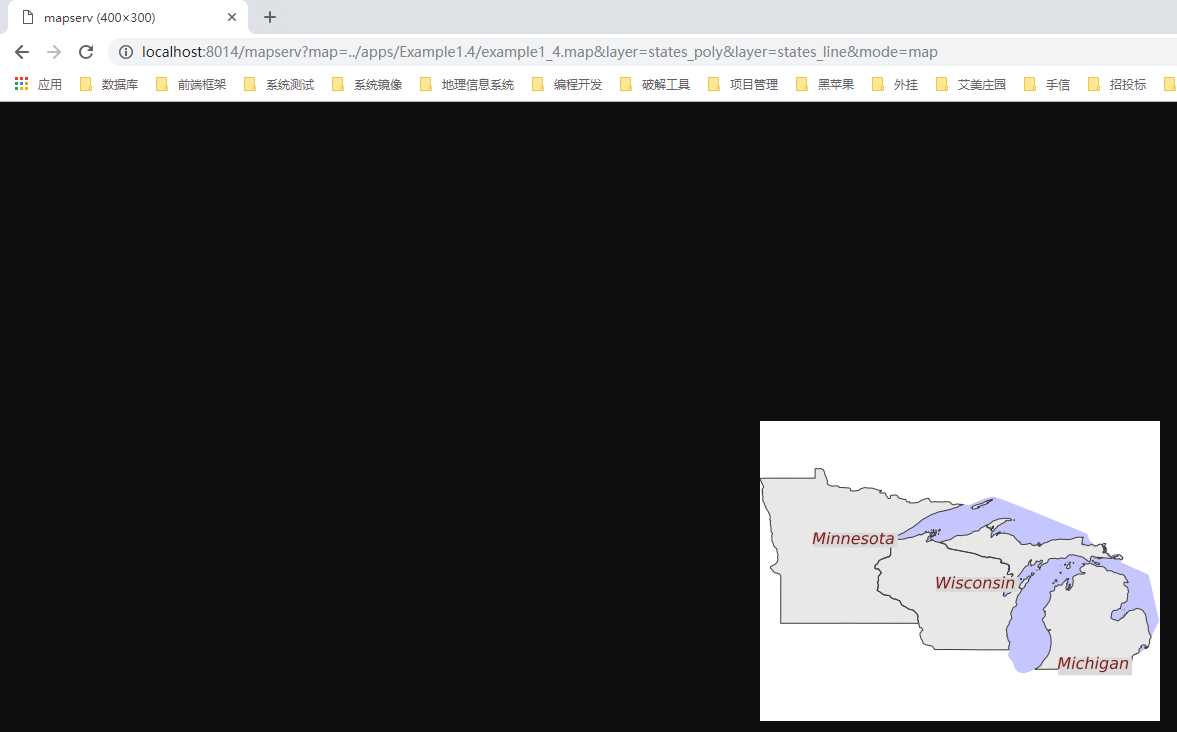
可以使用相对路径,也可以使用绝对路径,然后字体已经变为斜体。
字体相关数据信息网站:https://www.freetype.org/
LABELITEM
上一章学过CLASSITEM,LABELITEM与其有类似的理解。
但是其与CLASSITEM又不相同,LABELITEM是指定显示某个字段中的数据,当前案例中是“STATE”。
LABELITEM 在 LAYER 标签中,而 LABEL 在 CLASS 标签中。所以目前只显示三个标签的原因是:只有 CLASS 中 EXPRESSION 为 land 的 几个图形才会显示标签,同时MINDISTANCE决定了重叠的标签在执行像素内不显示。
可以在cmd中输入:cd /d E:\SvnWorkspace\LY_WEB_GIS\branches\Documents\ms4w-mapserver-for-wimdows\release-1911-x64-gdal-2-3-3-mapserver-7-2-1\apps\Example1.4\data
在cmd中输入:ogrinfo -al -ro states_ugl.shp 查看所有的数据。
在cmd中输入:ogrinfo -al -so -where CLASS=‘land‘ states_ugl.shp 查看 CLASS=‘land‘ 的概要数据。
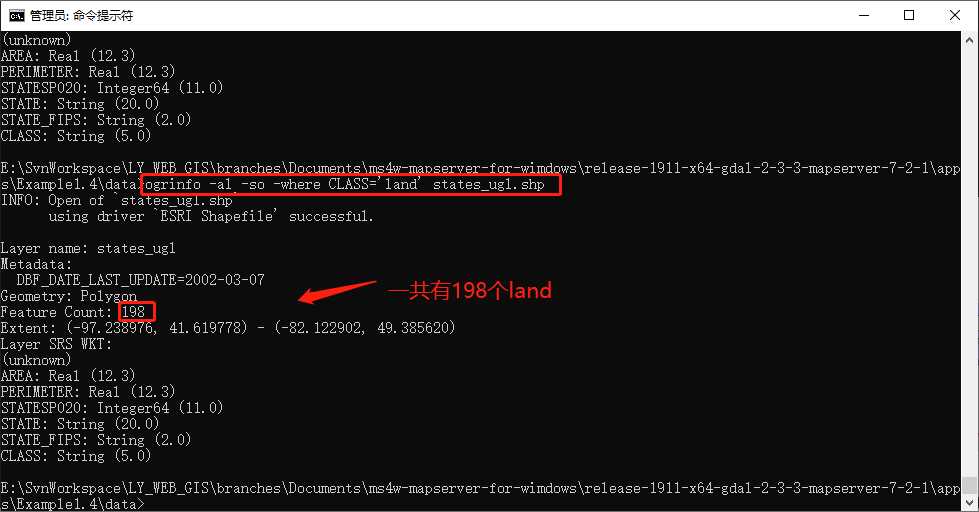
如果将MINDISTANCE修改为100时,刷新浏览器,你会发现,又出来了一个标签。
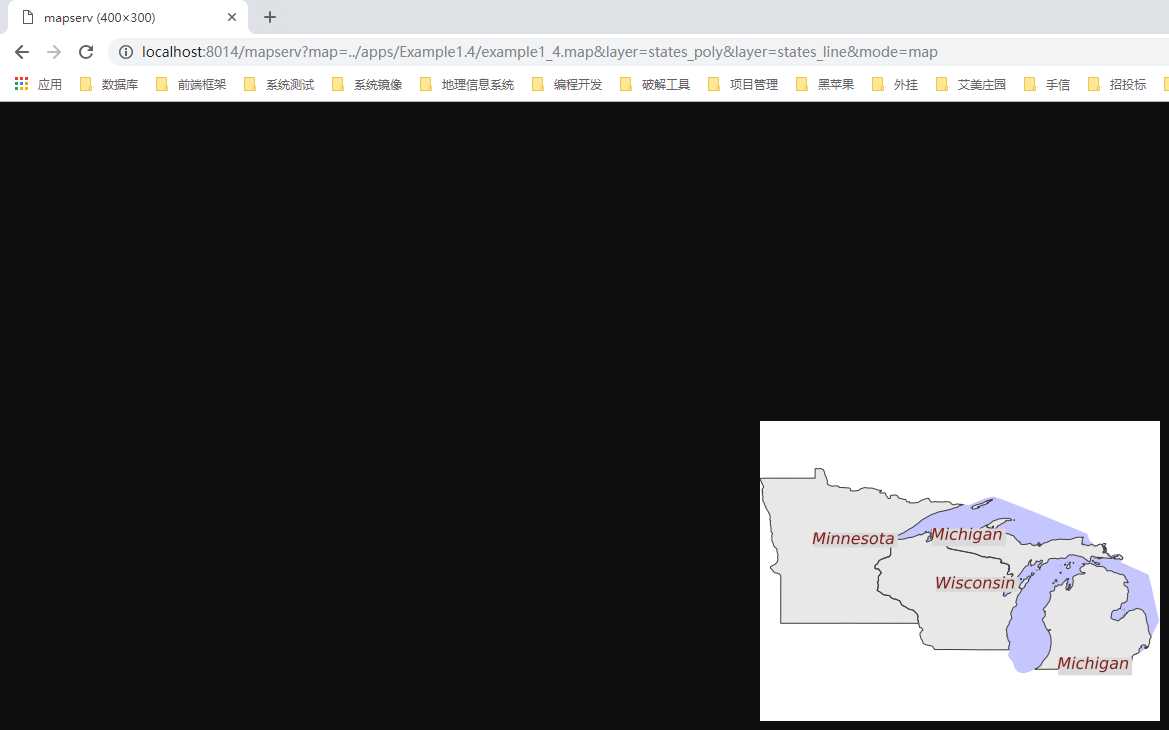
LABEL
以LABEL标签开头。LABEL对象在其他对象中使用,当前案例是在CLASS对象中使用,也可以在其他标签中使用,如:SCALEBAR。
LABEL标签的详情见:https://www.mapserver.org/mapfile/label.html
COLOR
目前案例中位于LABEL中的COLOR是用来定义label中的文字颜色。
SHADOWCOLOR
文字的阴影颜色。(自MapServer 6开始,LABEL STYLE 被 GEOMTRANSFORM LABELPOLY 所替代。其实mapfile中已经更新,只是官网上面的说明没有更新。)
SHADOWSIZE
文字阴影的尺寸,由X,Y组成,2 2 表示2像素宽,2像素高。(自MapServer 6开始,LABEL STYLE 被 GEOMTRANSFORM LABELPOLY 所替代。其实mapfile中已经更新,只是官网上面的说明没有更新。)
其实看到此处,以及对照官网上面的相关文档,我又很多疑问。首先查看几处资料:
1.https://www.mapserver.org/mapfile/geomtransform.html#labels-label-style-only
其中“Labels (LABEL STYLE only)”中写道如下:
The following simple geometry transformations are available at the LABEL STYLE level: #在LABEL标签的STYLE标签中,使用GEOMTRANSFORM有两种类型,分别为:labelpnt 和 labelpoly labelpnt labelpoly
These are used for label styling (background colour, background shadow, background frame). #他们是为label的背景颜色,背景阴影,背景框架做样式设置的。
Note The result of using labelpnt is affected by the LAYER LABELCACHE setting. If LABELCACHE is ON (the default), the label will be shifted when a non-zero sized symbol is added using labelpnt.
labelpnt and labelpoly
GEOMTRANSFORM “labelpnt”
GEOMTRANSFORM “labelpoly”
Note Only available for STYLE in the LABEL context.
These transformations can be used to make background rectangles for labels and add symbols to the label points.
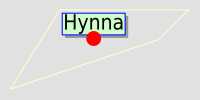
Class definitions for the example:
CLASS
STYLE
OUTLINECOLOR 255 255 204
END # STYLE
LABEL
SIZE giant
POSITION UC
#好了,第一个的疑问就在此处,同样 LABEL 中 GEOMTRANSFORM 的值均为"labelpoly",是如何判断当前 设置的为:阴影、背景颜色、还是边线呢?
#设置shadow难道是因为style标签中有 OFFSET 标签吗?
#设置 backgground 是因为只有COLOR,没有其他标签吗?
#设置outline是因为有OUTLINECOLOR标签,和WIDTH标签吗?
#我实在是有点费解。
STYLE # shadow
GEOMTRANSFORM "labelpoly"
COLOR 153 153 153
OFFSET 3 3
END # Style
STYLE # background
GEOMTRANSFORM "labelpoly"
COLOR 204 255 204
END # Style
STYLE # outline
GEOMTRANSFORM "labelpoly"
OUTLINECOLOR 0 0 255
WIDTH 1
END # Style
STYLE
GEOMTRANSFORM "labelpnt"
SYMBOL ‘circlef‘ #此处是自定义符号,设置红色圆点的。
COLOR 255 0 0
SIZE 15
END # Style
END # Label
END # Class
Symbol definition for the circlef symbol:
SYMBOL
NAME "circlef"
TYPE ellipse
FILLED true
POINTS
1 1
END # POINTS
END # SYMBOL
2.https://www.mapserver.org/mapfile/style.html 中对GEOMTRANSFORM有段定义
GEOMTRANSFORM [bbox|centroid|end|labelpnt|labelpoly|start|vertices|<expression>]
Used to indicate that the current feature will be transformed before the actual style is applied. Introduced in version 5.4.
Note Depends on GEOS.
Example (polygon data set) - draw a two pixel wide line 5 pixels inside the boundary of the polygon:
STYLE OUTLINECOLOR 255 0 0 WIDTH 2 GEOMTRANSFORM (buffer([shape],-5)) END
There is a difference between STYLE and LAYER GEOMTRANSFORM. LAYER-level will receive ground coordinates (meters, degrees, etc) and STYLE-level will receive pixel coordinates. The argument to methods such as simplify() must be in the same units as the coordinates of the shapes at that point of the rendering workflow, i.e. pixels at the STYLE-level and in ground units at the LAYER-level.
LAYER NAME "my_layer"
TYPE LINE
STATUS DEFAULT
DATA "lines.shp"
GEOMTRANSFORM (simplify([shape], 10)) ## 10 ground units
CLASS
STYLE
GEOMTRANSFORM (buffer([shape], 5) ## 5 pixels
WIDTH 2
COLOR 255 0 0
END
END
END
3.https://www.mapserver.org/mapfile/label.html 也有一段对STYLE的使用定义
STYLE
The start of a STYLE object.
Label specific mechanisms of the STYLE object are the GEOMTRANSFORM options: #此处也说明了,在STYLE对象中使用 GEOMTRANSFORM ,当然,前提是基于 LABEL 的使用 STYLE
GEOMTRANSFORM [labelpnt|labelpoly]
Creates a geometry that can be used for styling the label. Does not apply to ANGLE FOLLOW labels.
The resulting geometries can be styled using the mechanisms available in the STYLE object.
Example - draw a red background rectangle for the labels (i.e. billboard) with a “shadow” in gray:
STYLE GEOMTRANSFORM ‘labelpoly‘ COLOR 153 153 153 OFFSET 3 2 END # STYLE STYLE GEOMTRANSFORM ‘labelpoly‘ COLOR 255 0 0 END # STYLE
New in version 6.0.
TYPE
指定LABEL使用的字体类型。TRUETYPE 或 BITMAP。
FONT
指定使用哪种字体。如果指定TYPE为TRUETYPE,你需要指定使用哪种字体。
SIZE
指定字体的大小,TYPE为TRUETYPE时,使用像素;TYPE为BITMAP时,使用如:small、large。
ANTIALIAS
truetype类型字体的抗锯齿开关,值为:TRUE或FALSE。
POSITION
label标签中文字在label标签中的位置。其值由垂直位置和水平位置组成。
垂直位置的值由三个,分别为:C(中间,center)、U(上面,upper)、L(下面,lower)。
水平位置的值由三个,分别为:C(中间,center)、L(左边,left)、R(右边、right)。
缺省值:AUTO
PARTIALS
告诉MapServer是否生成完整的标签文本(个人认为是,如果标签中文本长度过程,则缺省显示),值为:TRUE或FALSE。
MINDISTANCE
设置重叠标签的最小距离,像素。(个人认为是按照两个标签的开始位置比对计算。)
BUFFER
设置标签填充外边距(像素)。用于增强可读性。(其实如果会前端CSS的应该比较容易理解padding,简单理解就是表示两个盒子之间的空白边距。)
四、后记
在做这个例子的过程中,遇到了一些尚未理解的位置。LABEL中的STYLE 下面 的 GEOMTRANSFORM 重点标记一下。
然后学会了更多的用命令查询shp数据。 -ro:只读打开文件。-al:列出所有数据。-rl:将所有数据重点关键数据进行展示。-where:像查询语句一样,根据条件过滤展示数据。
MapServer Tutorial——MapServer7.2.1教程学习——第一节用例实践:Example 1.4 Labeling the Map
标签:clu lines 网上 method ticket ann 案例 css make
原文地址:https://www.cnblogs.com/eshinex/p/10290066.html